Time is the ultimate equalizer. It is also one of the few things at which we are completely at the mercy.
Eventually, time in the guise of the Grim Reaper catches up with all of us. Before that happens, though, if we are fortunate, we get to enjoy at least a few decades on this side of the veil.
As I was reflecting on the passing of time a little earlier this month, I was struck by the fact that we had hit the point in the year at which my next birthday now lies less than two months away.
I was also stopped square in my tracks to realize that roughly half a year had passed since the last edition of my ongoing Cemetery Journeys blog post series that was launched in the summer of 2021.
We kicked off this series by first visiting Kelowna Memorial Park Cemetery in Kelowna, British Columbia.
Then, in the afterglow of Halloween and Samhain, with November’s piercing chill returning to our days once again, we headed a touch further north in the province and spent some very enjoyable time at Mt. Ida Cemetery in Salmon Arm, BC.
In the third installment of this exciting series, we are going to land fairly close to smack, dab in the middle of these locations. Doing so on a delightful spring day where – true to seasonal form – the light frequently shifted from vividly sunny to moodily overcast.
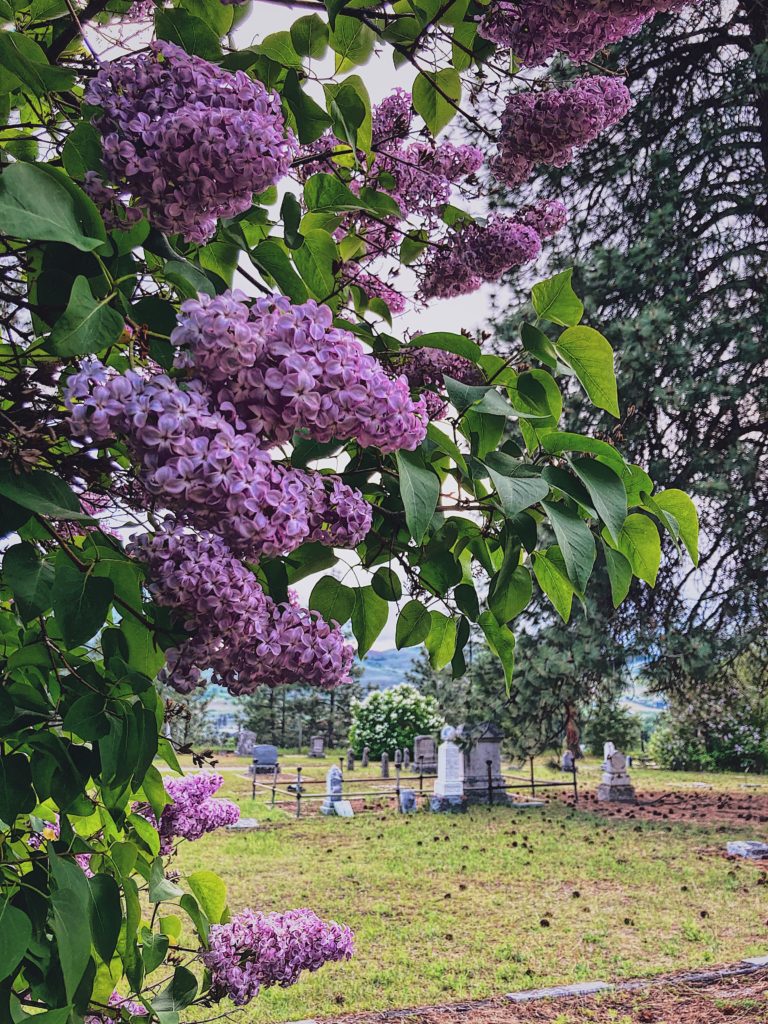
This image, like all of the other modern-day photos of Pleasant Valley Cemetery in this post, was taken by me. You are welcome to share and repost my photos of this cemetery for non-commercial purposes. Please credit them to Autumn Zenith and WitchcraftedLife.com when doing so. Thank you! )
Throughout the previous two Cemetery Journeys entries, I discussed some important points to keep in mind when exploring the cemeteries of Western Canada (British Columbia is Canada’s westernmost province and as such has a shoreline that is lapped by the mighty Pacific Ocean).
These include the fact that while settlement by non-First Nations people has only occurred in this part of the world over the past two hundred years or so (and even then, most areas were settled more in the range of 175 – 100 years ago at this point in time), the indigenous communities that filled not only BC, but Canada as a whole, lived in these rugged lands for millennia before the first Europeans are known to have set foot on Western Canadian soil.
Dovetailing with that point is the fact that as a result, there are no truly old non-First Nations burial sites to be had in this province.
Hitting upon cemeteries with headstones that proceed the 1890s – 1910s is worth celebrating and is not something one finds at every community, town, or city here in British Columbia.
Luckily, however, for history adoring taphophiles like myself, our current region of BC has been settled (again, by non-First Nations people) from about the middle of the nineteenth century onward.
As a result, some – though not all – of the burial grounds in this general area include headstones that predate the 1900s. Albeit often only by a matter of years or a couple of decades.
Still, I will gladly take that and usually make a point of trying to find the oldest headstone I can when visiting a cemetery (at least on my first trip there).
Despite living less than half an hour’s drive away from it, quite some time had passed since I last stepped foot on the hallowed ground that is Pleasant Valley Cemetery in the nearby town of Vernon, BC.
What better time to do just that than the early to mid-days of spring, when the natural world is bursting to life again and one can navigate the great outdoors without the need for double digits worth of thermal layers. 😄
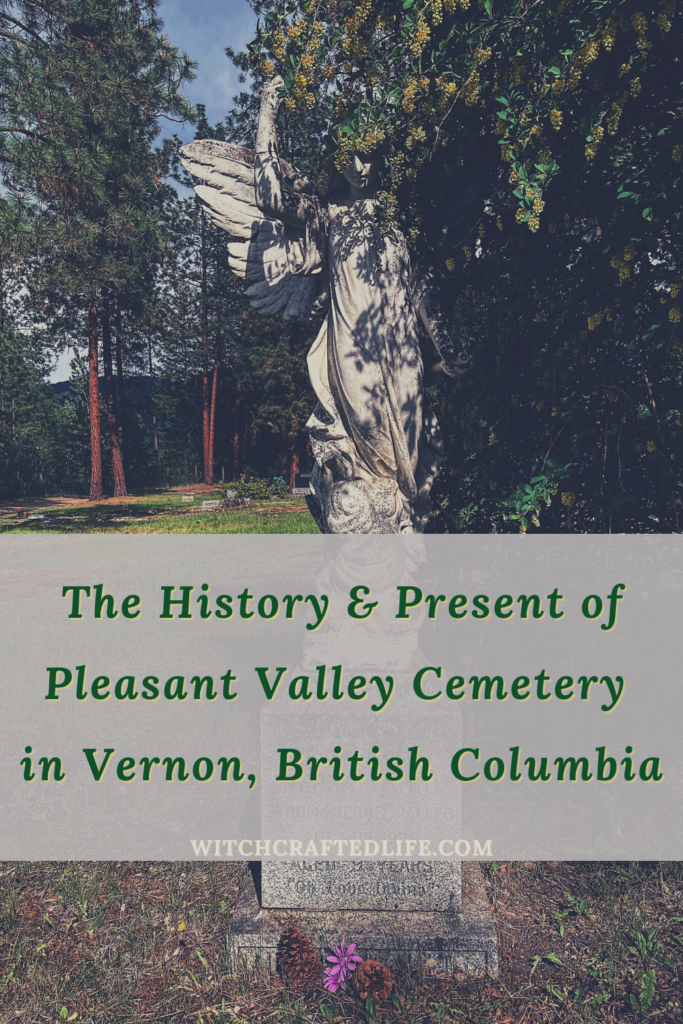
Enter our latest visit to Pleasant Valley Cemetery (a name that untold numbers of cemeteries in the English speaking world are called, believe me, I know 😄), which took place on a mild, subtly breezy springtime afternoon during which the sky bellyflopped back and forth between radiant sunshine and heavy grey clouds looked as though they had a lot to get off their chests.
It was Monsieur Soleil who won out in the end, but the mix of both types of light helped to add all the more of an atmospheric quality to our cemetery outing.
I shall soon invite you all along with me as we take a leisurely stroll across the gently sloping hills and tree-flanked pathways of Pleasant Valley Cemetery. First, however, let us briefly delve into the history of the community in which this burial ground is located: Vernon, BC.
A quick overview of the history of Vernon, British Columbia
Located in the northern end of BC’s well-known Okanagan Valley, which itself is situated in the Southern Interior area of this province, Vernon is a town with a rich history and yet, it often seems to play second fiddle to the larger nearby city of Kelowna.
This makes sense in many ways, of course, given that Kelowna is the biggest city (“biggest” being a somewhat relative term here 😄) in the entire Okanagan Valley.
However, Vernon is a terrific community unto itself and one that I feel deserves no less time in the limelight than Kelowna.
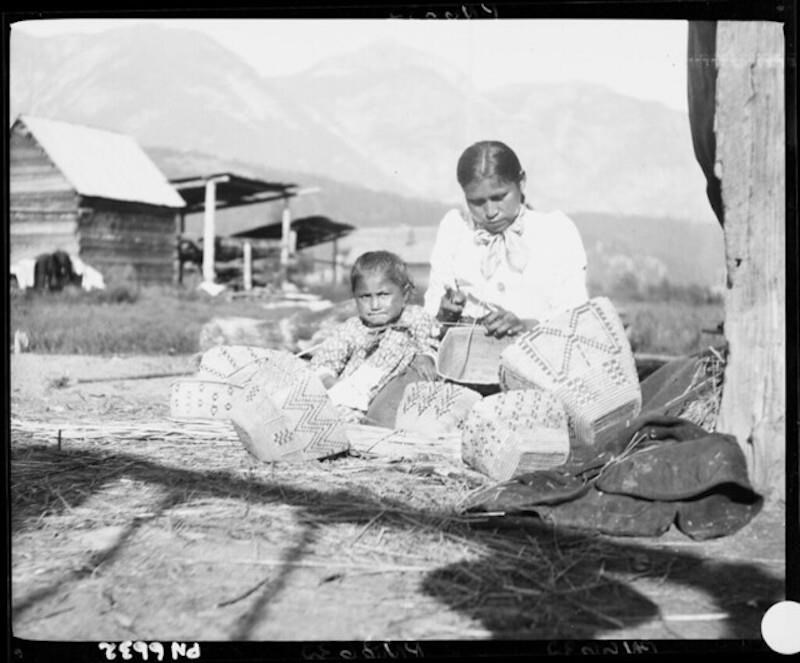
Located about 440 kilometres (270 miles) to the northeast of Vancouver, the area that is today known as Vernon was initially discovered and settled by members of the Interior Salish Okanagan people.
The name for Vernon in Salish was Nintle Moos Chin, which roughly translates to “jumping over creek”.
This title stems from part of a local body of water (now called) BX Creek which was narrow enough in some spots to jump straight over from bank to bank.
In the 19th century, as missionaries such as Father Pandosy who we met when chatting about the history of Kelowna, began to make their way into the interior of British Columbia, Nintle Moos Chin would be renamed Priest’s Valley by the local English speaking community.

During at least part of the 1870s, it also went by Forge Valley in reference to politician, businessman, early Okanagan settler and rancher, Price Ellison’s blacksmith shop. In 1884, Price married Sophia Christine Johnson, Vernon’s first school teacher.
Today the Ellison name lives on throughout various corners of the Okanagan Valley, including both the lovely unincorporated community of Ellison and Ellison Provincial Park.
As that same century wore on, the area’s English name would again change, this time landing on the one that it holds to this day: Vernon.
A name which was bestowed on the community in honour of Mr. Forbes George Vernon, an early member of the Legislative Assembly of British Columbia, who along with his brother Charles Vernon, owned one of the largest early ranches in the area.

In one of those truly cool instances that highlight the interconnectedness of humanity, Mr. Forbes’s father, John Edward Venables Vernon’s family had for a number of generations resided in Clontarf Castle in Dublin, Ireland.
Having operated as a fine dining restaurant and four-star hotel since 1997, this is the very same castle where, in 2004, Tony proposed to me.)
Just as you will find many people residing in these beautiful areas today, the original First Nations inhabitants of Nintle Moos Chin/Vernon often lived in close proximity to the two lakes that this city houses: Swan Lake and Okanagan Lake
The latter is the largest lake in the whole Okanagan Valley, spanning the continuous distance from Penticton in the Southern Okanagan to Vernon in the Northern Okanagan (the two are about 1.45 hours drive apart from each other).
A few decades before intrepid missionaries and other early non-First Nations inhabitants started to set up the seeds of a township in what is now present-day Vernon, the area was explored in the 1810s by fur traders.
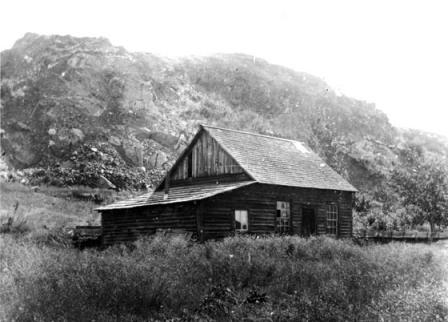
It is believed that a few decades later, a man by the name of Luc Girouard was the first permanent white settler in Vernon. He built a cabin in the area c. 1861 and would go on to plant Vernon’s first commercial orchards as well.
Little by little, the community began to grow, getting a sizable push towards developing from a small fur trading camp to a full-fledged community thanks to the 1863 discovery of gold in some of the eastern corners of the Okanagan (such as Mission Creek, Cherry Creek, and the Monashee Mountains, respectively).
Some feel that Vernon really got its start when, in 1863/64, the land that would become that township was purchased by Mr. William Campbell, who began – but did not complete – building the community’s first store.
This business-in-the-making was bought up by a stonemason named Mr. John Imlay, who had such illustrious projects under his belt already as working on the Parliament Building.
Much as in Kelowna to the south and Salmon Arm to the north, early Vernon was peppered with numerous ranches and, as time went on, no shortage of orchards either.

Speaking of which, in 1890, Lord and Lady Aberdeen – whose contributions to and influence in shaping the early history of the Central and Northern Okanagan areas lives on in numerous forms to this very day – purchased the Coldstream Ranch from Forbes Vernon. By 1892, they had planted at least a hundred fruit trees at the ranch in the hopes of accelerating the orchard industry in the area.
It is from the name Coldstream Ranch that the community that came to exist around it would later be named The District of Coldstream. Today, this community continues to thrive and is part of the Greater Vernon area.
In no time flat, Vernon and its surrounding communities would indeed succeed as a thriving fruit-growing (and later also viticulture) corner of Canada. Sun-kissed produce offerings grown in the hearty Okanagan soil are enjoyed by locals and shipped to food merchants around the globe to this very day.
Interestingly, throughout part of the 19th century, what would become the downtown core of Vernon was known as Centreville, a name that is rarely mentioned anymore and certainly no longer formally used in any capacity that I am aware of.
That downtown core would go on to form the city’s first business district, which came into being in 1885. This same year Vernon got its inaugural post office and a proper townsite was laid out and established for the city.
In addition to having a post office, Vernon was starting to blossom care of other firsts including a schoolhouse, hotel, and general store. A mere two years later, a Hudson’s Bay Company Store appeared on the scene as well.

Thanks in no small part to the abundance of cattle ranches that Vernon housed at the time, the area rapidly became a popular and successful economic hub for the Okanagan Valley.
Numerous forces drew early settlers to Vernon from corners near and far of Canada, as well as America, Europe, and elsewhere in the world.
The booming cattle and fruit-growing industries were two of the largest. Though, I am sure that the balmy summer weather that this region is so well-known for only helped to sweeten the deal for some of those early newcomers.
Growth and development in the area were aided all the more when the Canadian Pacific Railway (aka, the CPR) laid track that ran through parts of the Okanagan and on into the Shuswap, which is the region immediately following the Okanagan to the north.
Things did not stop hopping there in the 1890s, however! A mere two years later, a sternwheeler by the name of the S.S. Aberdeen (named for Lord and Lady Aberdeen) began to ply the waters of Okanagan Lake.

With both the railway and water travel now a part of daily life in the Vernon area, it was possible to bring in people, supplies, and animals considerably more quickly (and sometimes, more easily as well).
Also during the bustling 1890s, Vernon was officially incorporated as a city on December 30, 1892. Nine years later the first city hall was formed. It included both a public reading space and a fire hall.
Though it would, in time, be usurped on this front by Kelowna, back in those days, Vernon was the largest municipality in the Okanagan.
It was the first in which a telephone was installed and where a bank was built, amongst other things that Vernon accomplished sooner than any other part of the region.
As one drives into or exists through present-day Vernon from the south end of the city, they are bound to catch sight of a military camp and surrounding training grounds located there (which are often used for Cadet related purposes).

A military presence has been a part of Vernon’s landscape since 1908 when the Okanagan Mounted Rifles military program was established.
Later to be known as the 30th Regiment BC Horse – or more commonly, the Okanagan Mounted Rifles.
Throughout both World War I and World War II, Vernon’s population expanded further due to the influx of military personnel and their families who settled – be it temporarily or longer-term – in the area as a result of the army training that took place in Vernon.
Traversing the same stretch of highway that runs through the military training area in Vernon, you will quickly catch sight of the Vernon Jubilee Hospital.
It is a large, multistory medical facility that serves not only Vernon itself but also the residents of many other smaller towns and communities (ours included) in the general vicinity.

This hospital was established in the 1900s and remains the only one in Vernon to the present day.
One piece of Vernon’s history that very few people are aware of is that for a time this city was home to what we would today call something along the lines of a mental health treatment centre, but which at the time was known as a mental asylum.
Originally constructed as a jail, the building operated as a mental health facility from c. 1902 – 1912. After which point patients residing there were sent to the Provincial Insane Asylum in New Westminster. In the years to come, this same building was used as an internment site during WW1.

Its use between the end of that war and its demise due to a fire that happened circa the early 1940s is not well documented. Today, the WL Seaton Secondary School stands on a spot that – often unbeknownst to many who spend time there these days – surely saw no shortage of sorrows, suffering, and injustice during the first four decades of the previous century.
Throughout the 1910s and beyond, other elements that often help a community to grow and succeed were also set up. These included such services and amenities as a high school, sports stadium, and a bit further into the 20th century, an official library, and a modest-sized (to say the least! 😄) shopping mall called Village Green Centre.
While there is a bustling downtown business core, various plazas, numerous supermarkets and other shopping locations throughout Vernon, Village Green remains the city’s only mall.
(For better or worse, the Okanagan Valley is not rife with shopping malls and most of those that do exist here are scarcely large enough, IMO, to be crowned with that title in the first place.)

As the 20th century rolled onward and the province of British Columbia as a whole continued to expand both in terms of its population and its transportation routes, Vernon would go to connect with three different provincial highways. These are Highway 97, Highway 97A, and Highway 6, respectively.
Much as with the Okanagan Valley as a whole, Vernon experiences hot, sunshine-filled summers and cold winters that often reside in sub-zero temperatures from mid to late autumn straight onto early spring.
The gorgeous months of warm sunshine have long helped to ensure Vernon was – and still is – a popular tourist destination, attracting many visitors to its arid climate, gorgeous lakes, and a plethora of surrounding mountains (some of which morph into popular ski hills such as Silver Star Mountain come the winter months) each year.

And speaking of the snowy side of the calendar, each winter Vernon comes alive care of the Vernon Winter Carnival, which was officially established in 1961. Though its roots stretch back to February 23, 1893, as that was when the first recorded winter carnival in the area took place. They would occur periodically between then and 1961, from which point onward they have been an annual event.
Today, Vernon’s is the largest winter carnival in Western Canada and the second biggest in all of North America (behind the well-known and much adored Quebec Winter Carnival).
On the flip side of the year, one finds the Vernon Sunshine Festival, an annual event that takes place in the downtown core of the city. This lively occurrence includes artisan booths, food trucks, live music, children’s events, and various other enjoyable happenings.
As with most parts of British Columbia, Vernon’s commercial structures and homes are a mix of old and new (with plenty that currently fall in between the two).
Downtown, on 30th Avenue (which is often considered to be Vernon’s main street), as well as elsewhere in the city centre, one finds an assortment of older buildings that have stood for numerous decades running.

The arts are well fostered and celebrated in Vernon, with, at the time of writing, no less than 27 different murals depicting scenes from the area’s history appearing on the sides of various buildings throughout the downtown core.
In addition, there is an excellent performing arts centre called the Vernon and District Performing Arts Centre, as well as the Powerhouse Theatre which is home to a great community theatre programme.
Located in what is arguably the city’s most beautiful public green space, Polson Park, one also finds the Vernon Community Arts Centre.
And just a few streets over locals and tourists alike can catch a film at the Vernon Towne Cinema, which was built in 1929 – 1930.
Much to the delight of early 20th-century architecture and history buffs, this movie theatre (which served in various other arts and entertainment capacities before becoming a cinema) retains much of its art deco design and charm.
And for those like myself, who swoon up a storm over all things creative and crafty, if you should happen to be in Vernon as spring sits on the cusp of summer, you can visit Chaos Crafts.
This annual event is the largest summertime craft show in Western Canada, attracting vendors and attendees alike from across BC, Alberta, and further afield.

Vernon has witnessed continued population growth for the majority of its lifetime and that has certainly rung true in recent decades.
In 2021, the population of Vernon proper came in at some 44,519 people (who are known as Vernonites). This number swells into the 60,000s, however, when surrounding communities are factored into the equation as well. Together, these areas form what is known as Greater Vernon.
Prior to moving to Armstrong (a town located about twenty minutes north of Vernon) in 2018, I had visited Vernon many times throughout my life (much of which has been spent in the Okanagan).
And once, for an ultra-brief matter of weeks in my teens, I even lived in Vernon.
In the years since we relocated to Armstrong, both Tony and I have gotten to know Vernon considerably better.
It is the nearest city to us (Salmon Arm, located north of our town, is the second closest) and as Armstrong lacks a lot of amenities (or at least any sort of variety of them), we often find ourselves spending time in Vernon – which neither of us mind at all.
Ever since I was a little girl and my family would take summertime road trips to various corners of the Okanagan and Shuswap Valleys, I have felt a connection to Vernon.
From its gorgeous heritage homes such as Campbell House and Mohr House to its equally lovely (unofficial) main street, its lakes (including the stunning Kalamalka Lake located on the southern edge of the city, which was once listed as one of the top ten most beautiful lakes in the world by National Geographic) to its arts and culture scene, Vernon has a good deal to offer both locals and visitors alike.

Kalamalka Lake takes its name from a highly revered First Nations man named Chief Kalamalka, who may have been born around 1800.
An early hotel in Vernon also shared his name and while it has not seen overnight lodgers for quite some time now, part of that building is still going strong. These days it is a popular local sports bar known as The Kal.
Should the occasion to do so arise for us one day, I would likely have no qualms about moving to Vernon. It might not be as big or have quite as much to offer as those larger BC cities that start with the letter V (aka, Vancouver and Victoria), but it is still substantially bigger than itty-bitty Armstrong.
While at the same time, in my personal opinion, it retains more of a cohesive community feel and spirit than that of ever-expanding Kelowna.
This makes all the more sense given that the Greater Kelowna Area more than doubles the population of the Greater Vernon Area.
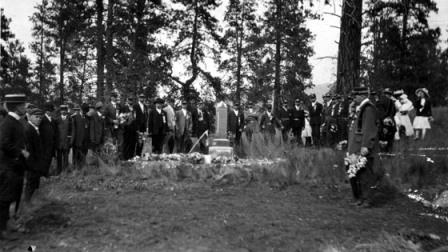
Like most towns and cities around the world, as Vernon’s population began to grow, it was only natural that a cemetery would be required.
Pleasant Valley Cemetery in Vernon
Just as with the previous two cemeteries that we have spent time exploring so far in this post series, Pleasant Valley is the largest burial site in its respective community.
Fascinatingly, however, Vernon’s first cemetery was not the one we will be wandering through together today.
No, the first cemetery in Vernon, BC, was located in the 3700 block of 35th Avenue on land donated for this very purpose by none other than Vernon’s first permanent white inhabitant, Luc Girouard.
This community burial ground came into being during the 1880s and had been known by a slew of different names such as “Vernon Cemetery”, “Old Cemetery”, and “Old Vernon Cemetery” before being given, on May 8, 1975, its current title of Pioneer Park Cemetery.
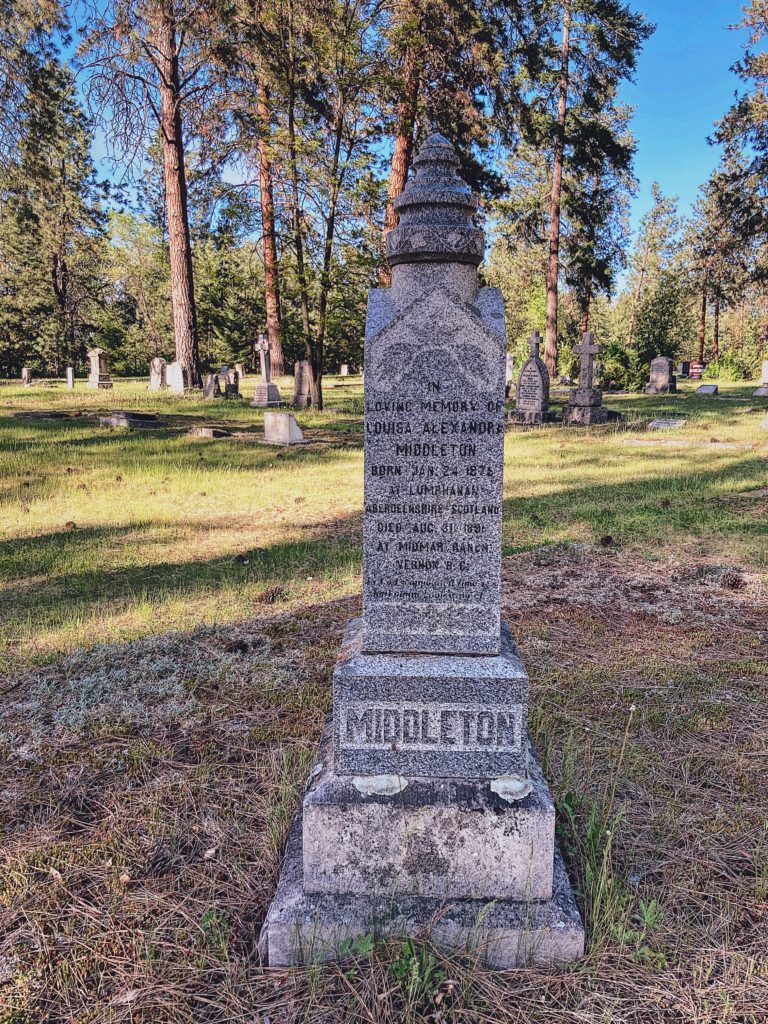
The first body to be buried at the Vernon Cemetery was, heartbreakingly, a one-year-old child named John William Hozier, who was laid to rest there in 1885.
As is apt to happen as communities expand, it did not take very long for Vernon’s relatively small original cemetery to become quite full (as well as, unfortunately, rather unkempt).
One or two years into the start of the 20th century, in either 1901 or 1902 (I have seen sources that cite both of those years), the City of Vernon opted to purchase land for use as a new cemetery.
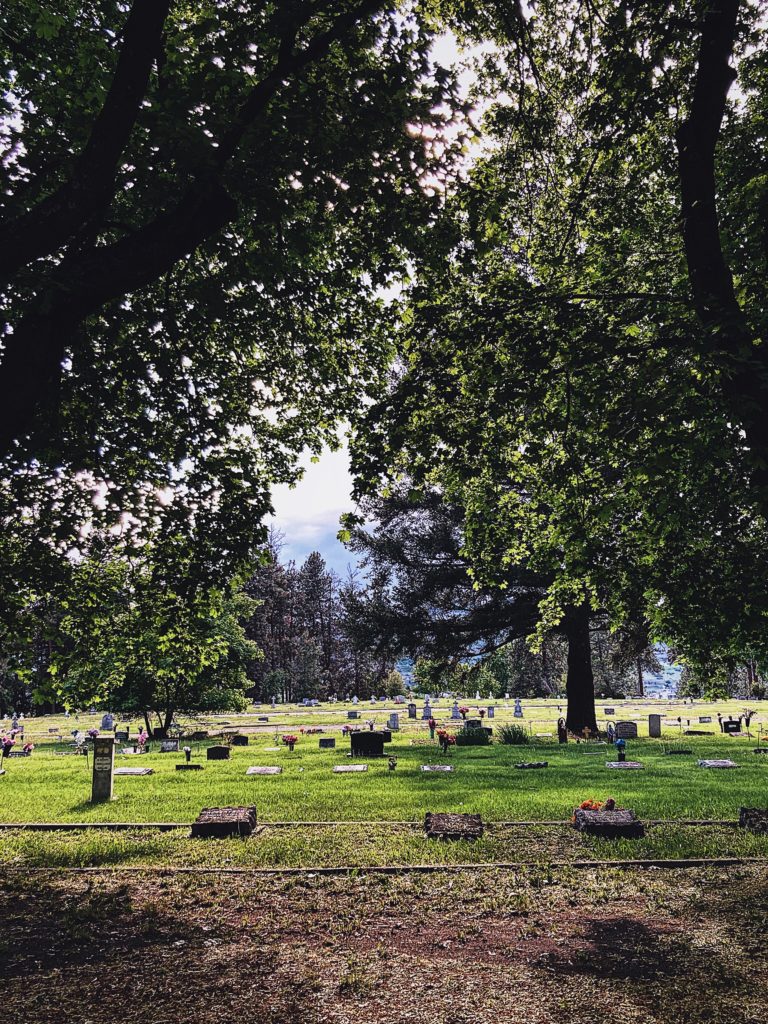
The land to do just happened to be located on Pleasant Valley Road, which naturally is where Pleasant Valley Cemetery derives its name from.
However, at the very beginning of its life, this location was known as both the Vernon Cemetery (just like its predecessor) and the Vernon Municipal Cemetery.
Once this new cemetery had been established in Vernon, Pioneer Park Cemetery was closed for burials. In the decades since, all of the burial plots have now been removed (with many being reinterred at Pleasant Valley Cemetery).
And in a lovely nod to the history of that piece of land, some of the grave markers were used to build a memorial wall at the east side of the old cemetery, which is today a small public park called Pioneer Park Cemetery.
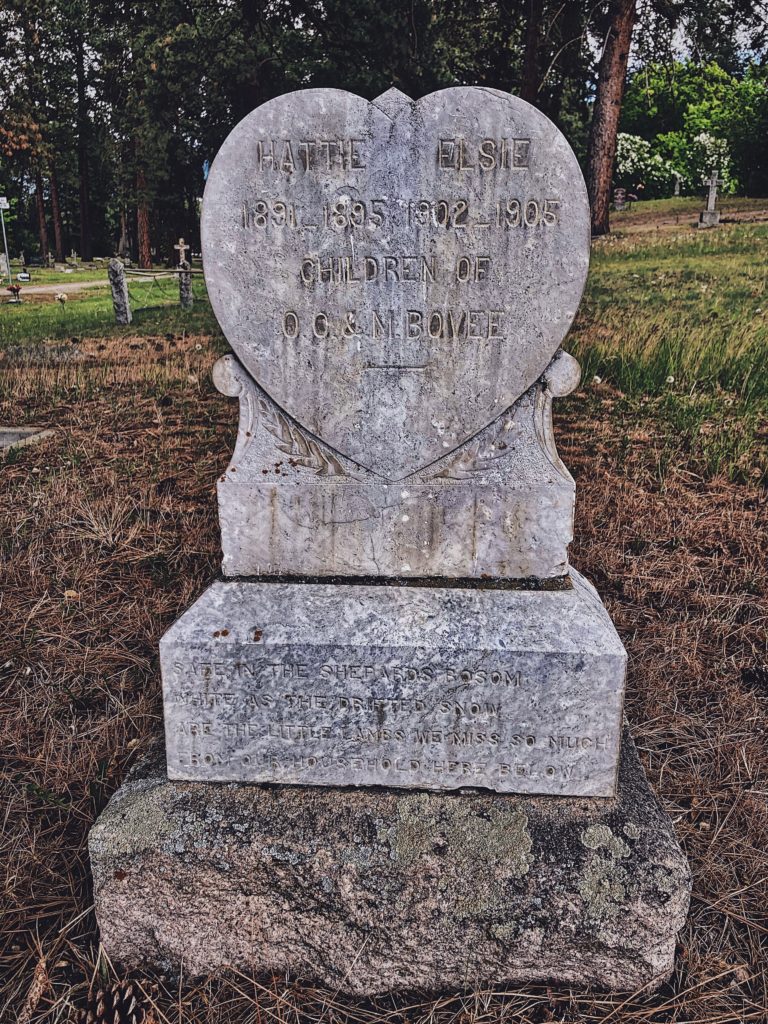
Others – much like those laid to rest beneath them – were moved to Pleasant Valley Cemetery. And it is very cemetery that we will now be diving straight into exploring together.
Located at 4311 Pleasant Valley Road, Vernon, British Columbia, Canada, Pleasant Valley Cemetery has been in continuous operation for an impressive 120 – 121 years and counting at this point (that being 2022).
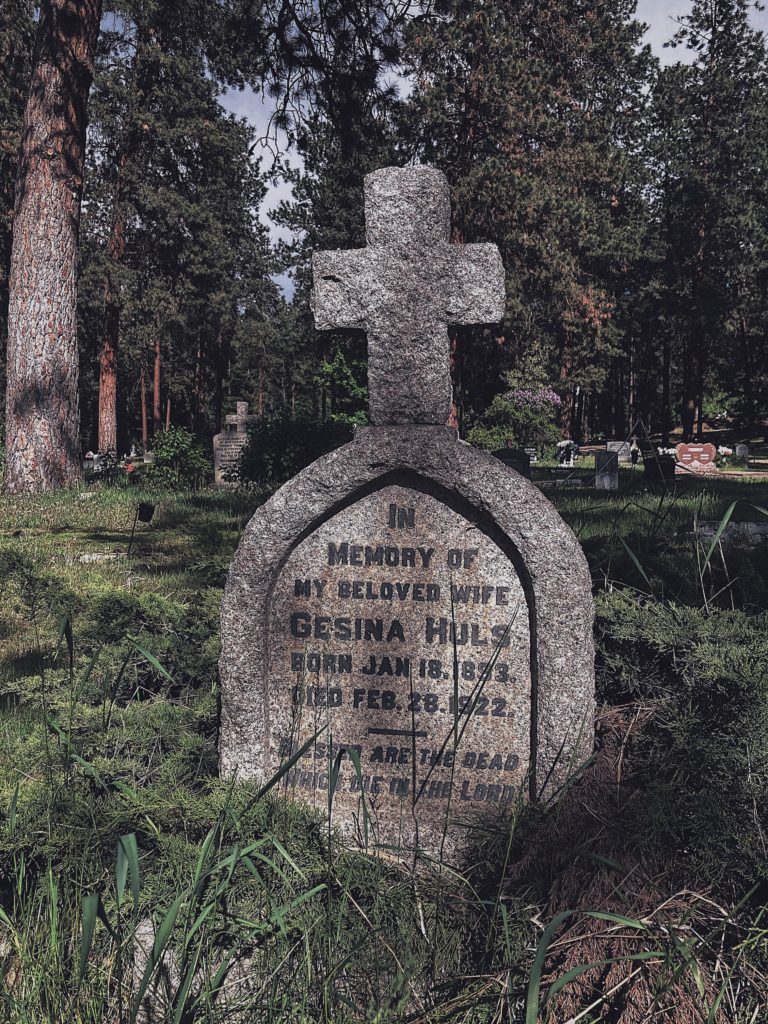
Those wishing to visit this cemetery can do so year-round during the following times:
March 15th – October 15th: 8 am to dusk
October 16th – March 14th: 8 am to 4 pm
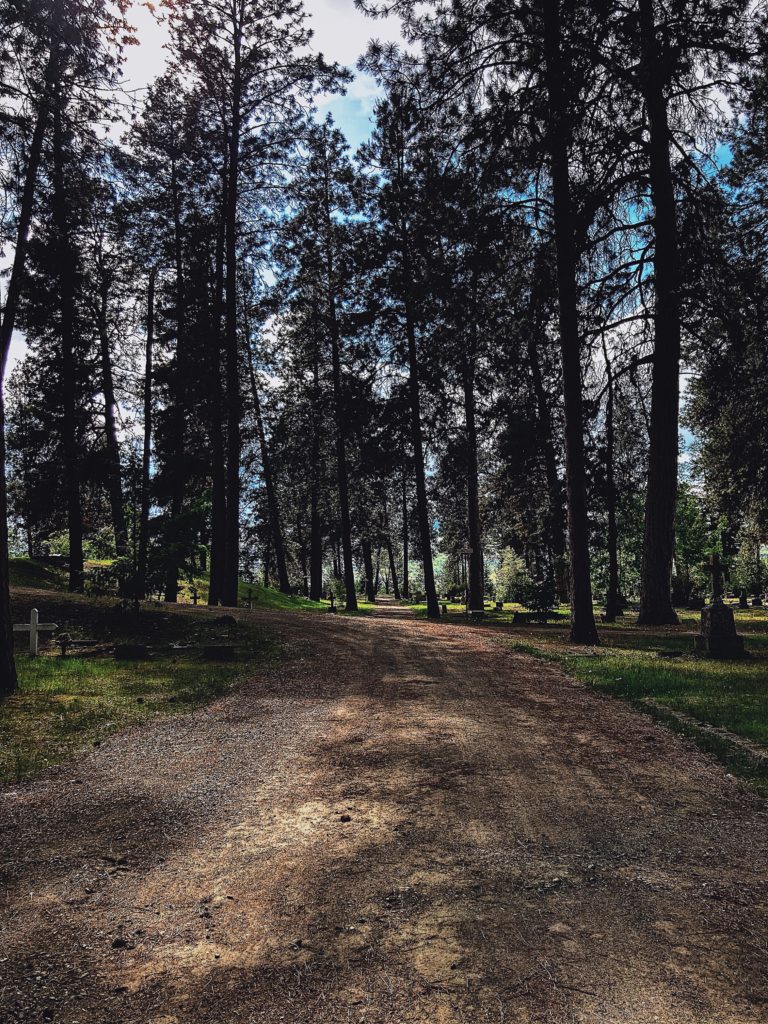
One enters Pleasant Valley Road Cemetery through a wide, somewhat low wrought iron gate attached to two stonework columns. Upon doing so, you will instantly be greeted by a serene (drivable) pathway that is heavily flanked on both sides by tall, lushly verdant trees.
From the outset, one might not expect Vernon’s main burial ground to be as large as it is when you simply pass by it on your way to somewhere else.
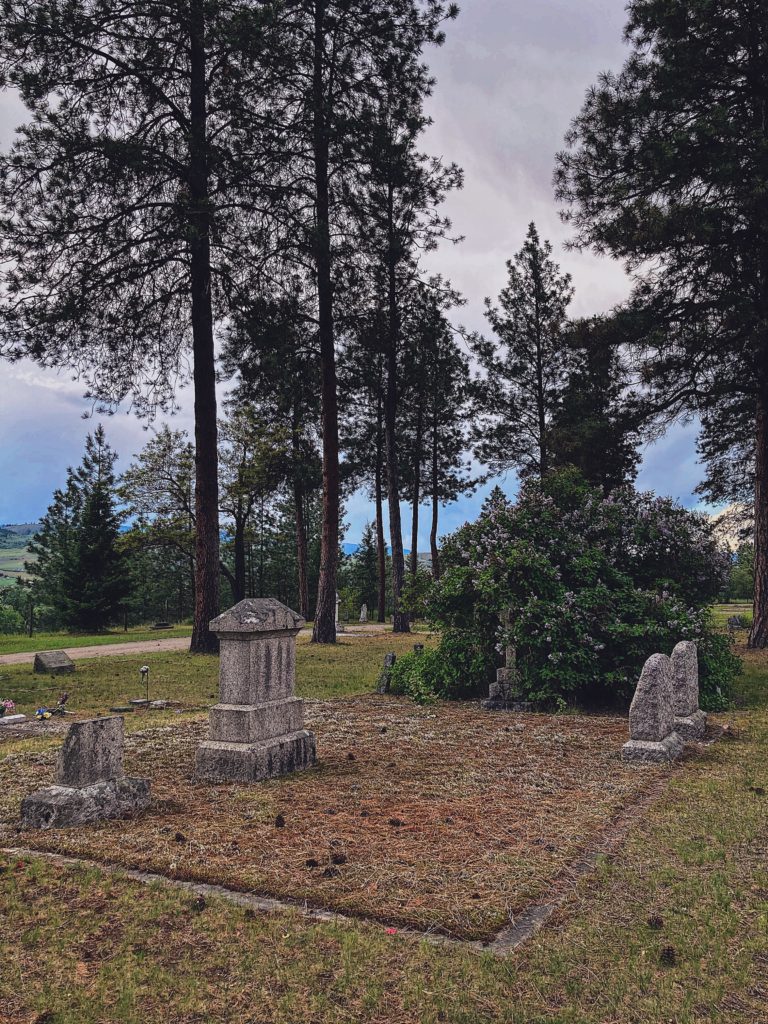
However, one need only walk a few metres into Pleasant Valley Cemetery to begin to get a sense of the expansiveness of this immensely lovely final resting place of more than 17,000 individuals and counting.
Vernon’s Pleasant Valley Road Cemetery is divided into two sections: Evergreen and Maple, both of which are then broken down further into blocks, rows, and plots in which ones finds a wide array of different marker styles spanning some that were moved there from the original Pioneer Cemetery straight on to burials as recent as the same season you are visiting.
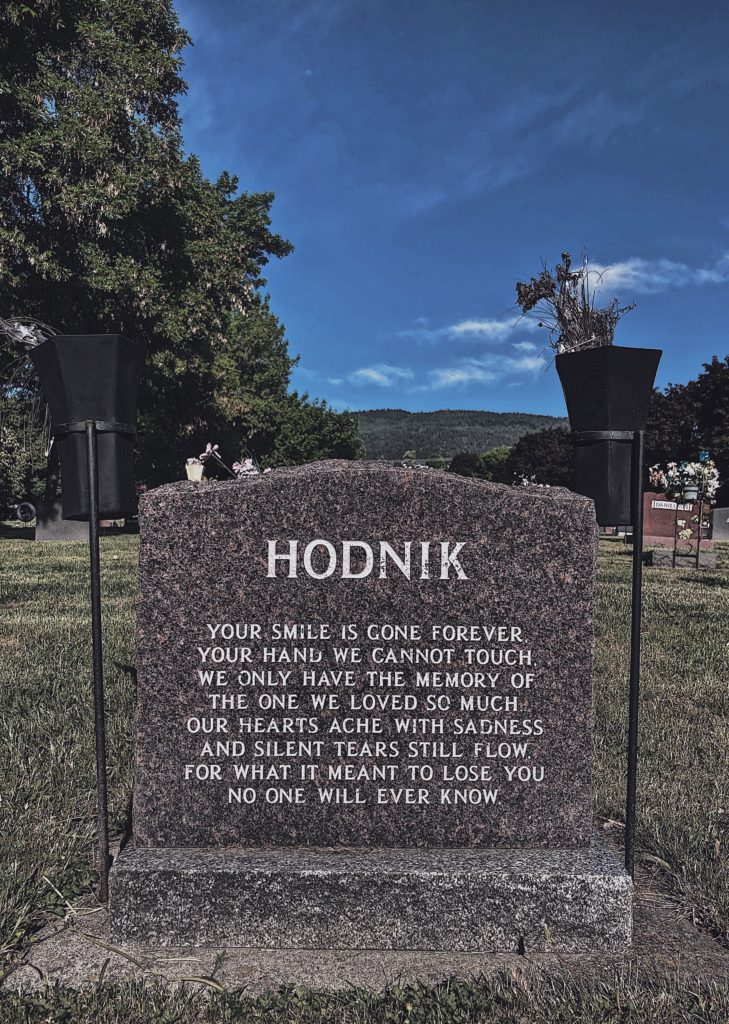
If you plan to walk around the cemetery, I would suggest wearing comfortable shoes in which your feet will not begin to ache quickly as you will be covering a decent amount of ground if you wish to see the whole of Pleasant Valley Cemetery on foot.
Naturally though, if one lives nearby or will be in the vicinity for multiple days, you could opt to explore various parts of the cemetery on different days.
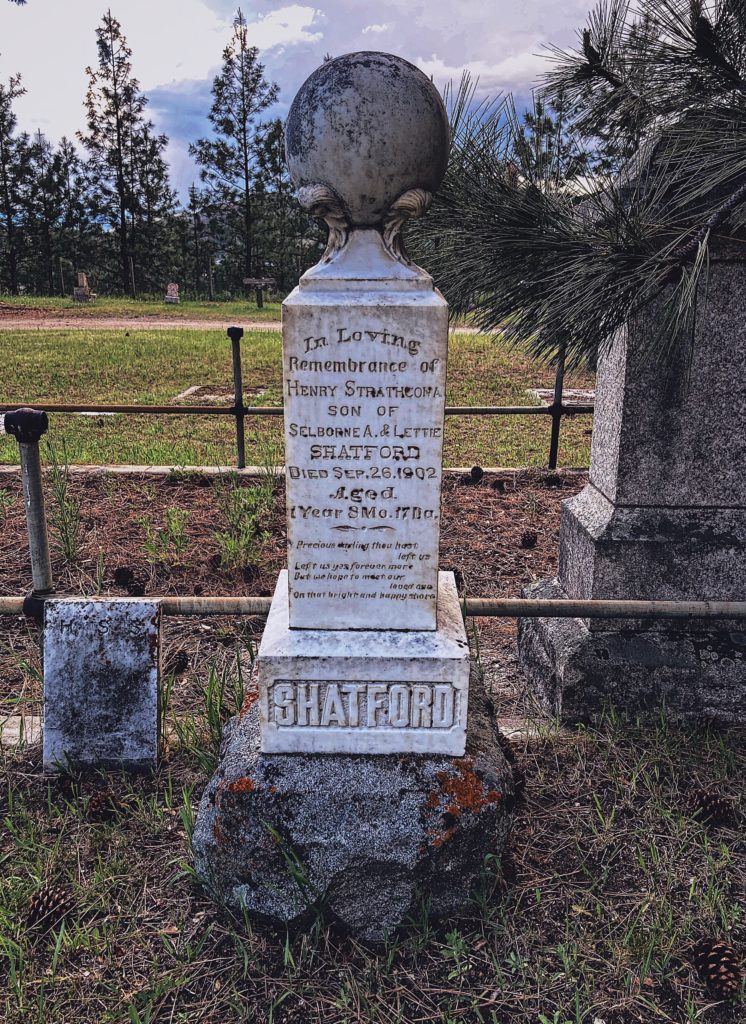
When this cemetery was established at the start of the 20th century, it initially covered an expanse of seventeen acres. However, it did not actually take very long for that space to be used up.
Therefore, as time went on, more of the adjacent land was purchased over the years to accommodate new burials (today it comes in at about thirty acres of land).
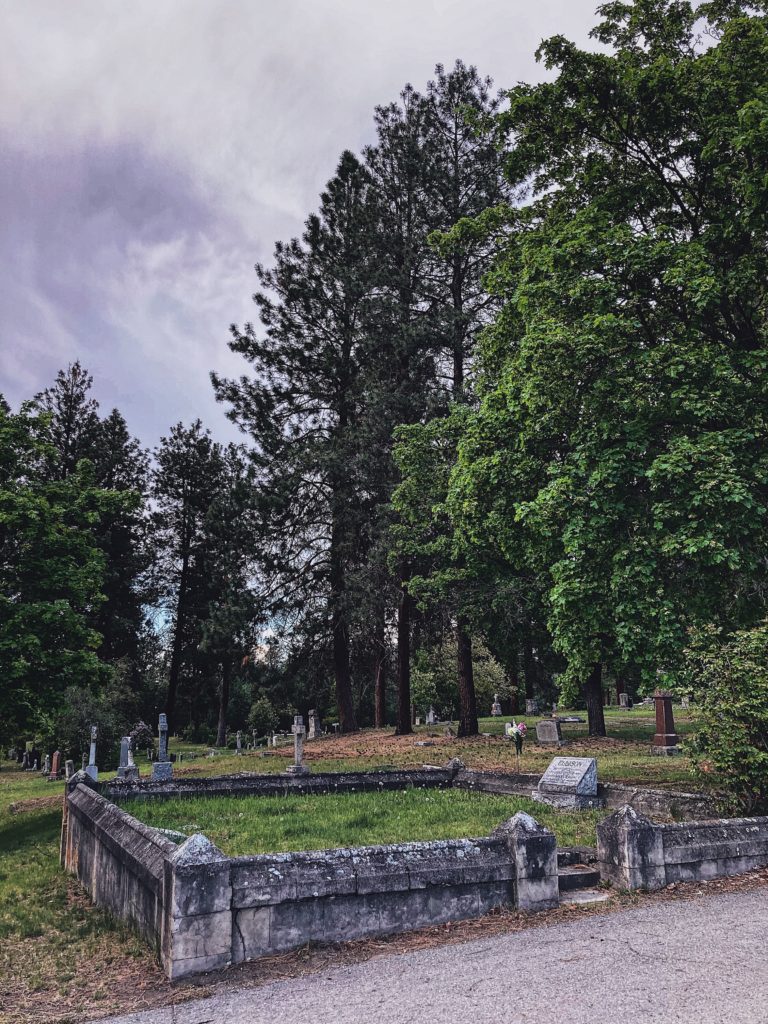
Prior to that point, however, in 1909, Pleasant Valley Cemetery witnessed a truly dark day when a fire at the Okanagan Hotel took the lives of eleven people.
A memorial was erected to honour a man named Archie Hickling, who perished in the blaze while helping to save others. In addition, a stone marker commemorates the victims of that tragic event which rocked the community of Vernon.
While Pleasant Valley Cemetery does not house anyone famous enough to likely be a household name the world over, it is home to a number of notable early residents and/or some of their family members. Amongst them is one of Price Ellison’s daughters.
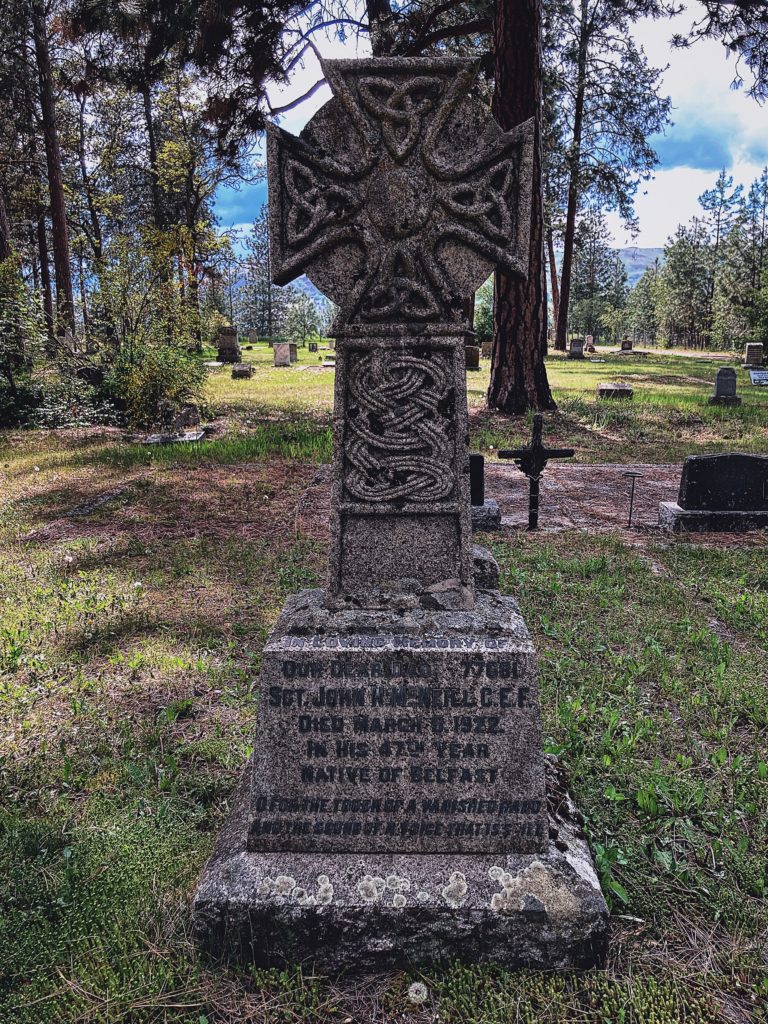
There are some strikingly beautiful older monuments and headstones (and a few wrought iron plot fences) to be had in Pleasant Valley Cemetery.
A good number of which were the work of skilled Scottish stonecutter William Inkster, who moved to Vernon in 1903 – a mere one year after the (then) new cemetery was opened.
Mr. Inkster (I love that last name, BTW) founded the Vernon Granite and Marble Company, with some of the earliest granite coming from the properties of the Lefroy family and that of Price Ellison, whose daughter was just mentioned.
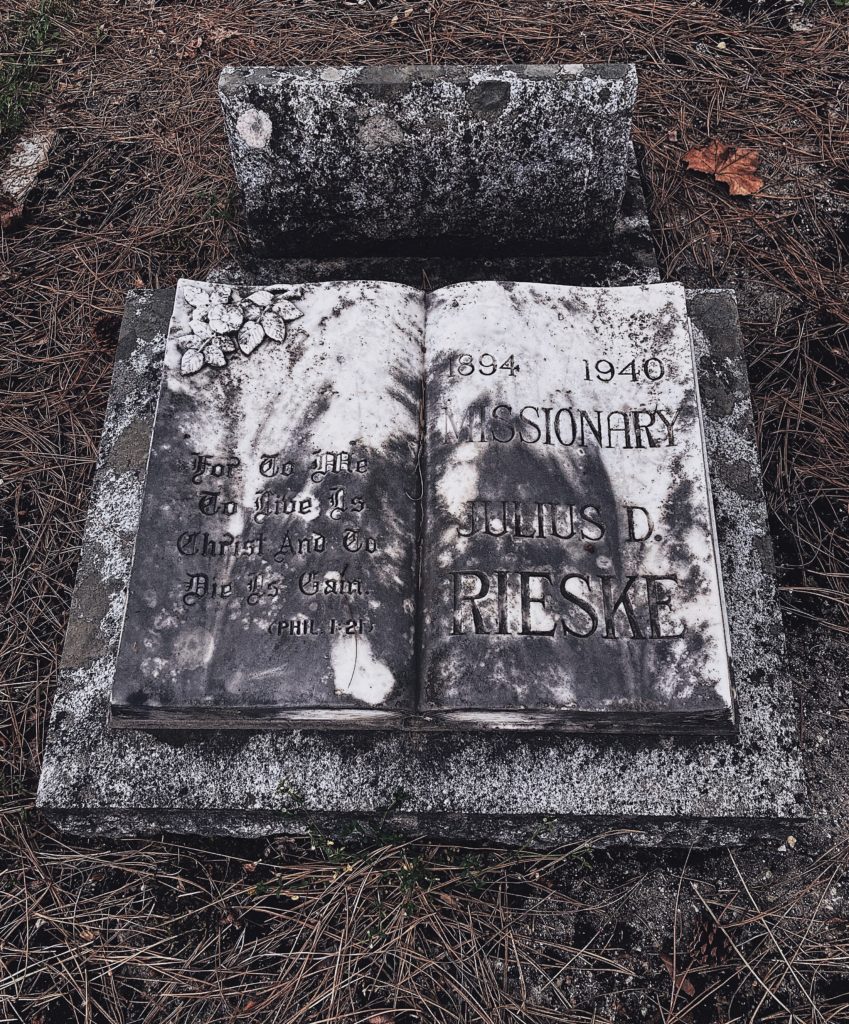
That granite can still be seen today in the antique headstones that still stand at Pleasant Valley Cemetery, quite a few of which include – as one would expect, especially for the time period – an array of Christian symbols and religious/spiritual inscriptions.
From very early on in its history, this cemetery has included a section that was/is designated for Chinese burials. Most of the markers located there are, naturally, in Mandarin or Cantonese.
While vertical headstones continue to be erected for some of the newer burials at this cemetery, the bulk of the recent cremation burials (as opposed to casket burials) are designated by small horizontal shaped markers that lay close to the ground.
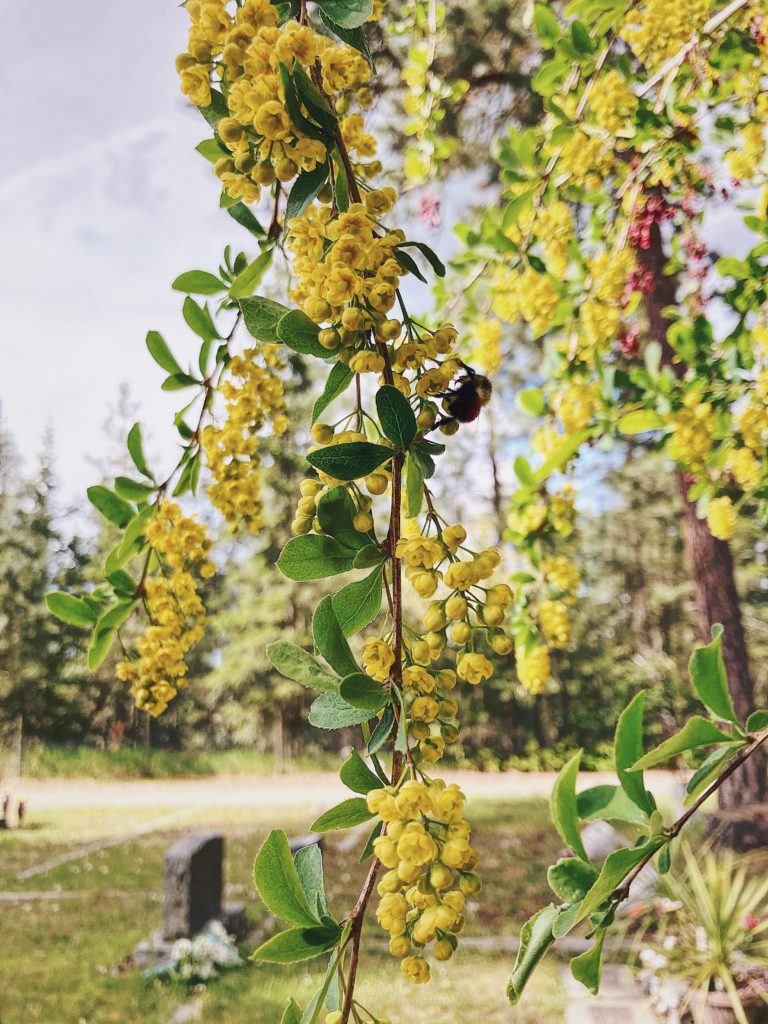
Many peacefully pretty trees (including plenty of pines) coupled with an array of flowering bushes call this cemetery home as well.
Their presence offers an additional element of tranquillity and helps to create an even more beautiful setting for those buried at Pleasant Valley Cemetery and those who visit it alike.
As touched on earlier in this post, one of the standout features of this cemetery is the sweeping and rather majestic view of the city and the mountains on the opposite side of Vernon that can be viewed from some spots throughout the grounds.
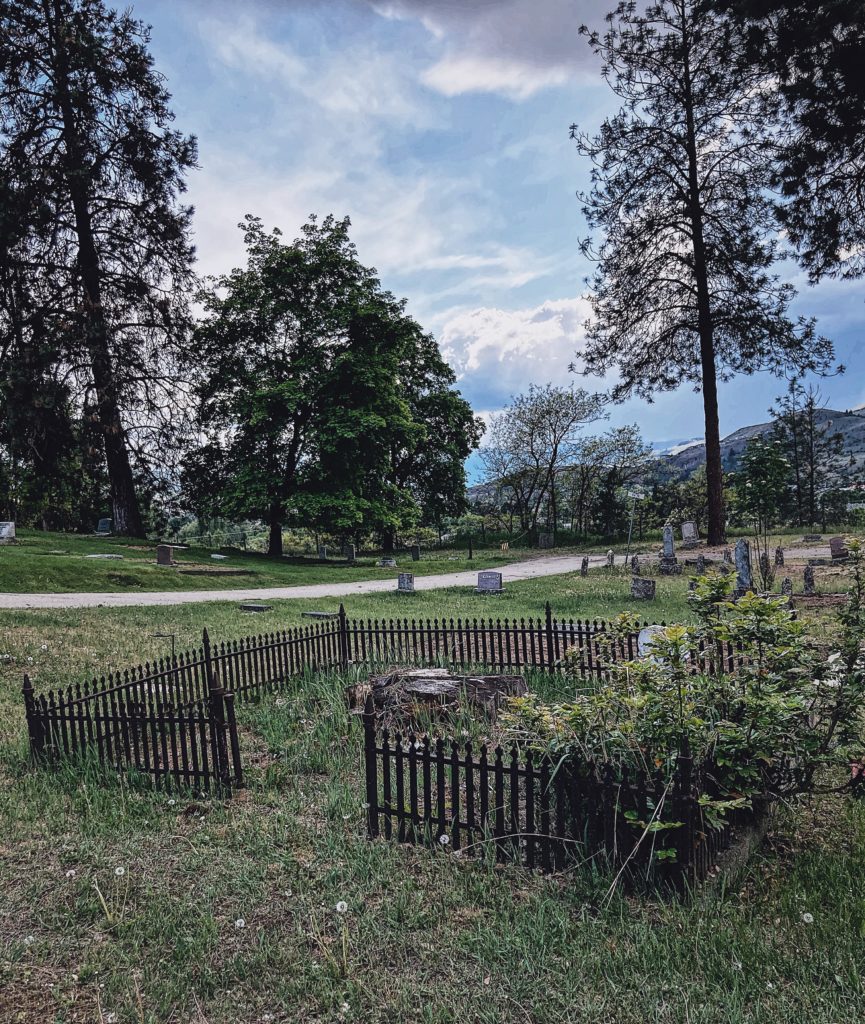
I have had the joy of visiting many cemeteries throughout my lifetime and I can confidently say that few had/have views quite as breathtaking as this deeply peaceful one.
In addition to an area being designated early on for the burials of Chinese citizens, separate sections were also portioned out early on for members of civic clubs (including the Oddfellows), as well as for infants.
Following WWI, a spot was set aside to be used specifically for members of the Great War Veterans Association.
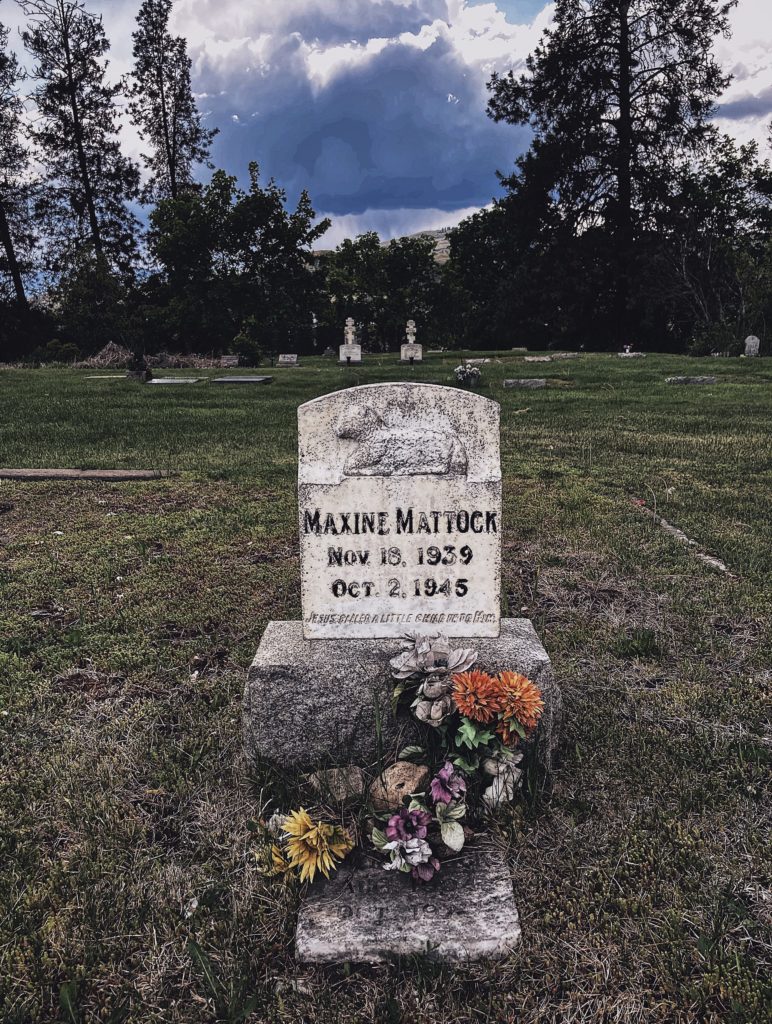
Areas were also singled for those who died while in the (devastatingly wrong and unjust) internment camps that were set up in the North Okanagan during both WW1 and WW2.
An October 2019 Vernon Morning Star article states that the first person to be buried in the city’s then newly established cemetery was a woman named Mrs. Ellen Johnson Wilding Weeks.
Originally from Shrewsbury, England, Ellen was born on January 22, 1847. She married a fellow named Thomas Weeks in 1867 and, nearly three decades later, the couple moved to Vernon with their five children.
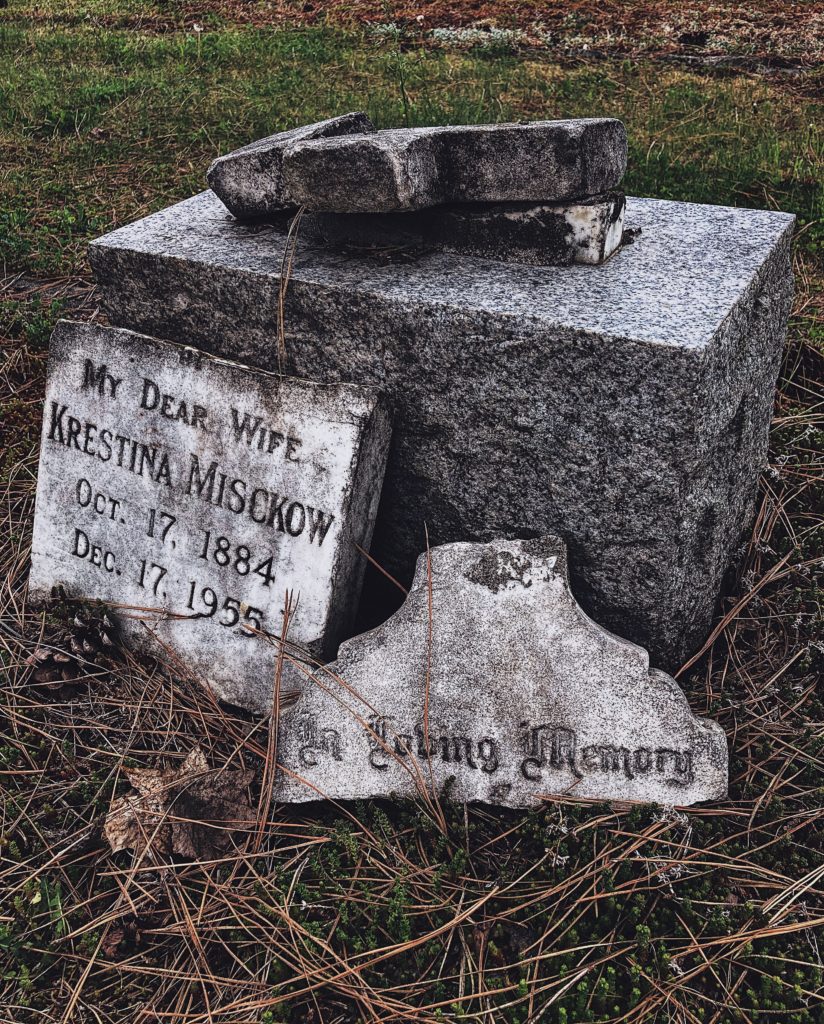
Rather interestingly, the home that Thomas Weeks built for his family to live in is still standing to this day. It is now known as the Rice House and can be seen on 20th Street in Vernon.
Sadly, on October 5, 1901, Ellen passed away from tuberculosis (then commonly called “consumption”) at the age of just 54 years old. Three days later she was laid to rest in Pleasant Valley Cemetery.
Less than two year on, her husband Thomas, aged 60, passed away from liver disease and was buried in the plot immediately alongside that of his beloved wife.
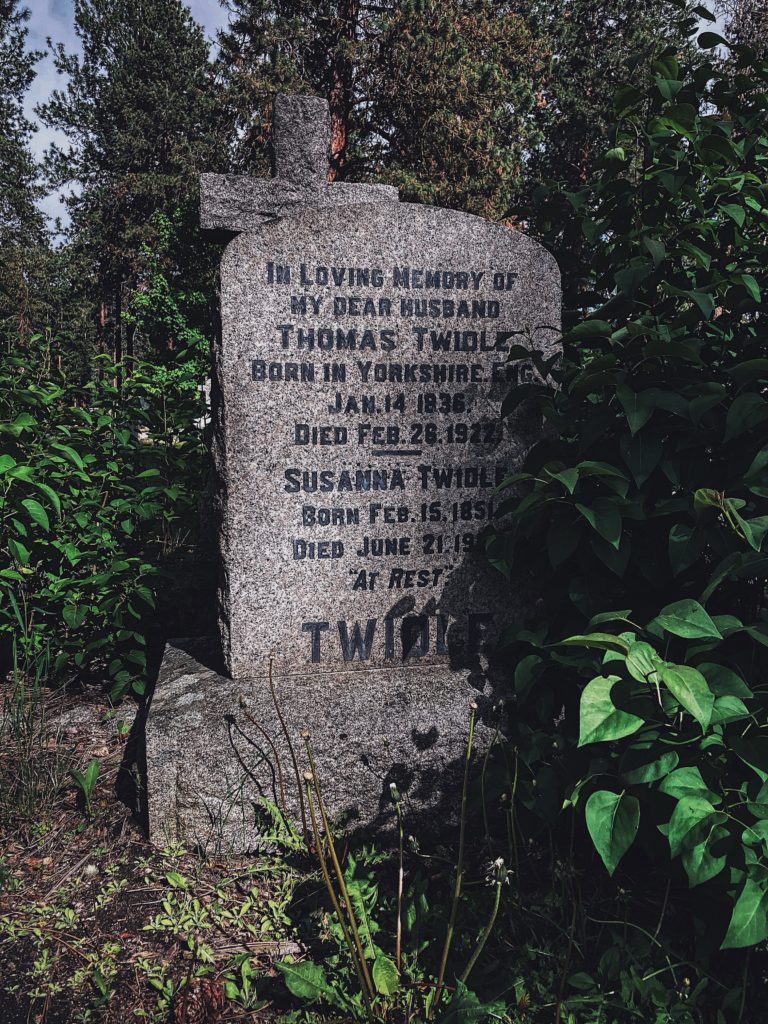
And while none of Ellen and Thomas’s children are interred at this cemetery, two of their grandchildren joined them at the family plot later on in the century.
(Note: If indeed that date was Ellen’s correct date of death, then it would imply that the cemetery was opened in 1901, not 1902. Though I am still trying to get some definitive answers there as both years are readily cited in various historical sources and online articles.)
However, due to the fact that some of the grave markers from Vernon’s very first cemetery were moved to Pleasant Valley, Ellen’s date of death is not the earliest to be had at this location.
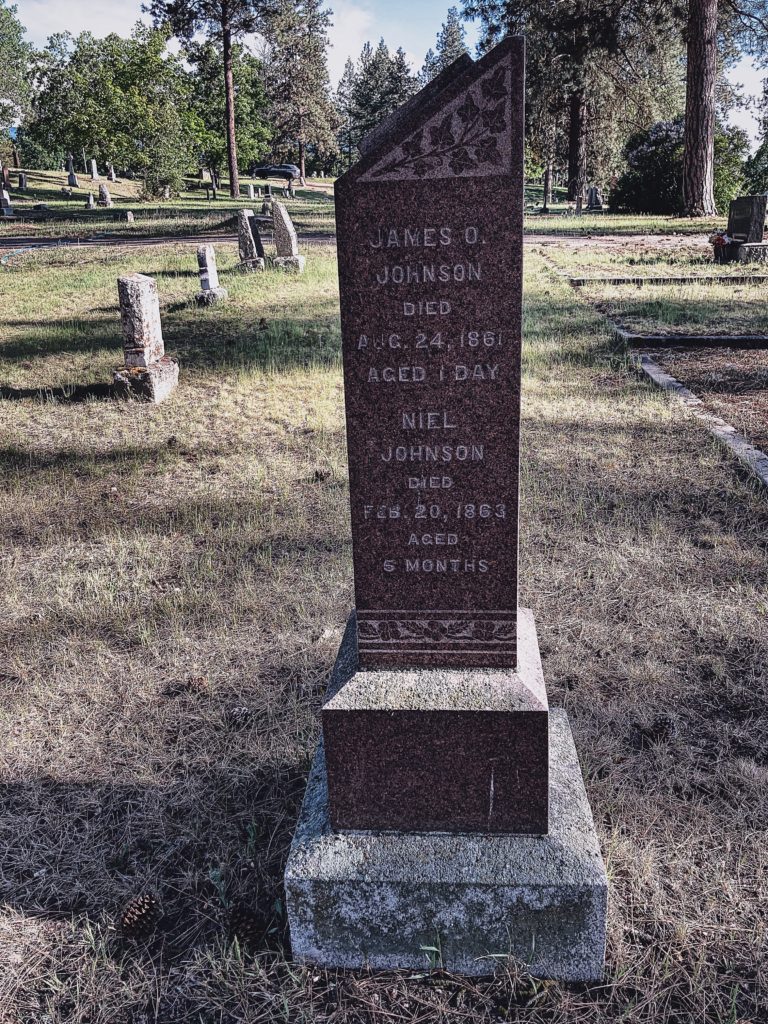
These belong to some of the members of the Johnson family who passed away on various dates in the two decades preceding the creation of the original Vernon Cemetery.
I am likewise trying to determine if these individuals’ bodies are interred at Pleasant Valley Cemetery or if markers have “just” been placed there in memory of these early Vernon pioneers.
Sadly, the earliest death that appears on these markers is that of James O. Johnson, who was born on August 23, 1861, and who perished the very next day.
In the years to come, three other Johnson family members would also pass away at devastatingly young ages, their names, in turn, appearing on this same stone as well.
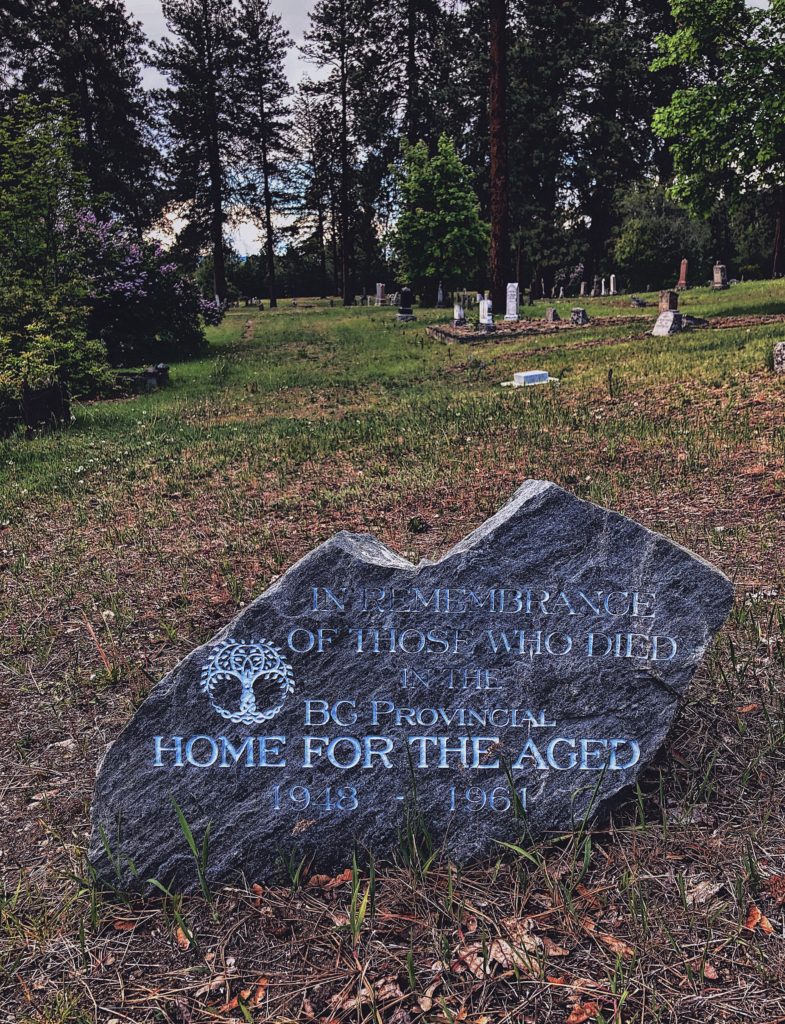
Another marker that will tug at the heartstrings of many who come across it is the inscribed memorial stone that was put in place as a memory of those who passed away between 1948 and 1961 in the Vernon-based BC Provincial Home for the Aged.
This marker came to be in recent times thanks to the hard work of two members (Alice Lee and Gilda Koenig) of the Vernon and District Family History Society who raised funds in order to have this stone created and placed at the cemetery.
Of the roughly 500 people who died in that government-run senior citizen’s home, it is believed that about 377 of them are buried at Vernon’s cemetery. However, only seventy or so of those people are laid to rest beneath headstones/markers, with the rest residing in unmarked graves.
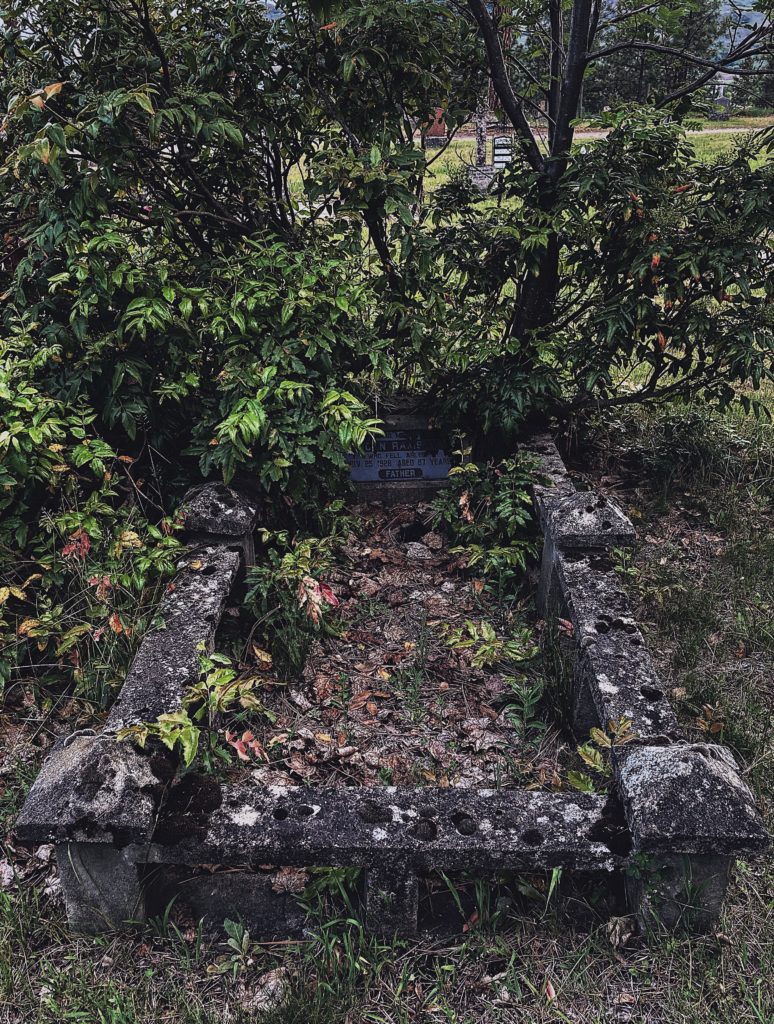
Not uncommonly, little to no information whatsoever is now known about these individuals, so it is all the more important that their memory not be lost entirely in the mists of time.
As such, in addition to the monument rock, forty-one other rocks have been placed in a row to commemorate this group of people further – many of whom died and were, unfortunately, buried alone (that is to say, without any of their family present).
Today, burials (be they of bodies or cremated remains) continue to take place at Pleasant Valley Cemetery.

However, according to a 2019 article in the Vernon Morning Star newspaper, the city believes – and is making advance plans for the fact that – there is likely only about 25 to 30 years of space left for new burials at this location.
While no new (burial) ground is being broken quite yet, the city – which owns the current cemetery – will strive to get a jump on the day when Pleasant Valley is at max capacity by starting work on a new cemetery at least five to ten years in advance of that estimated point in time.
I have not heard or read, but like to assume that when that day comes, the City of Vernon will continue to maintain Pleasant Valley Cemetery.
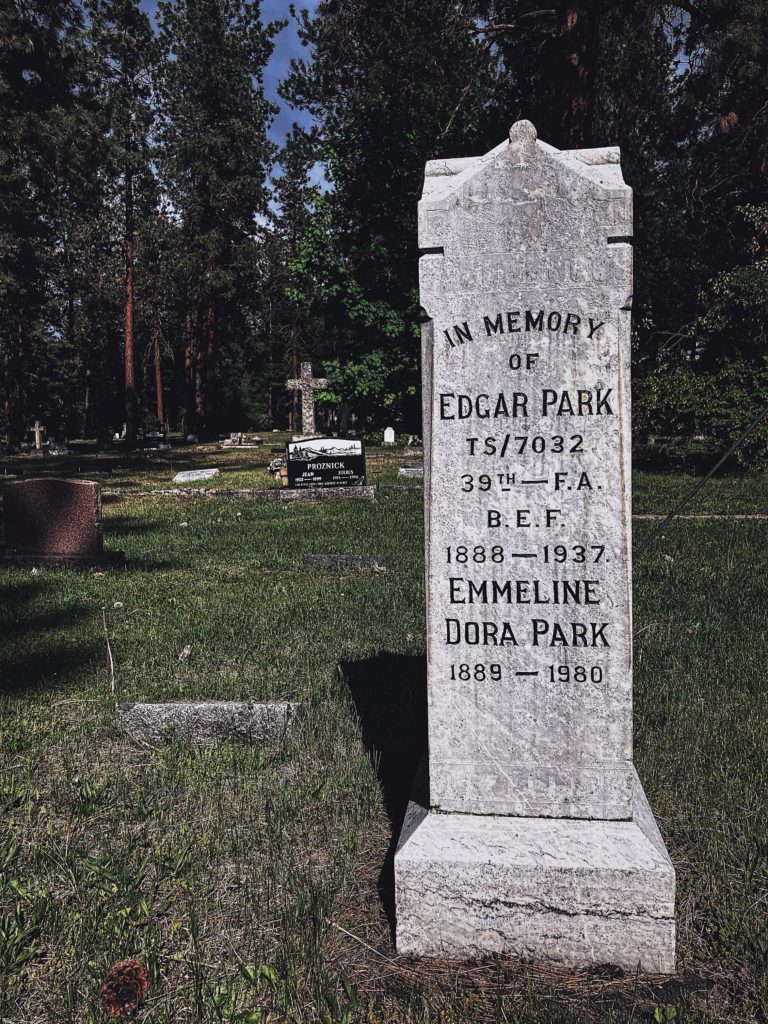
Time shall tell, but I for one will be keeping my fingers and toes tightly crossed when Vernon’s current cemetery reaches its limit and a new one is opened, Pleasant Valley will continue to stand as the beautiful, tranquil, and historically important spot that it is for many more generations to come.
The similarities and differences of cemeteries everywhere
Though this cemetery shares a moniker with scores of others around the world and there are additional common points to be had as well, like most burial grounds, it is not a carbon copy of any other out there.
This North Okanagan burial ground holds elements that help to set it apart and, in the process, endure it all the more to the hearts of many who spend time at Pleasant Valley Cemetery in Vernon, BC.
Ultimately, even when various cemeteries and/or graveyards are rather similar to one another, it is vital to remember that they will forever be differentiated from one another by the fact that different groups of individuals were interred at each one.
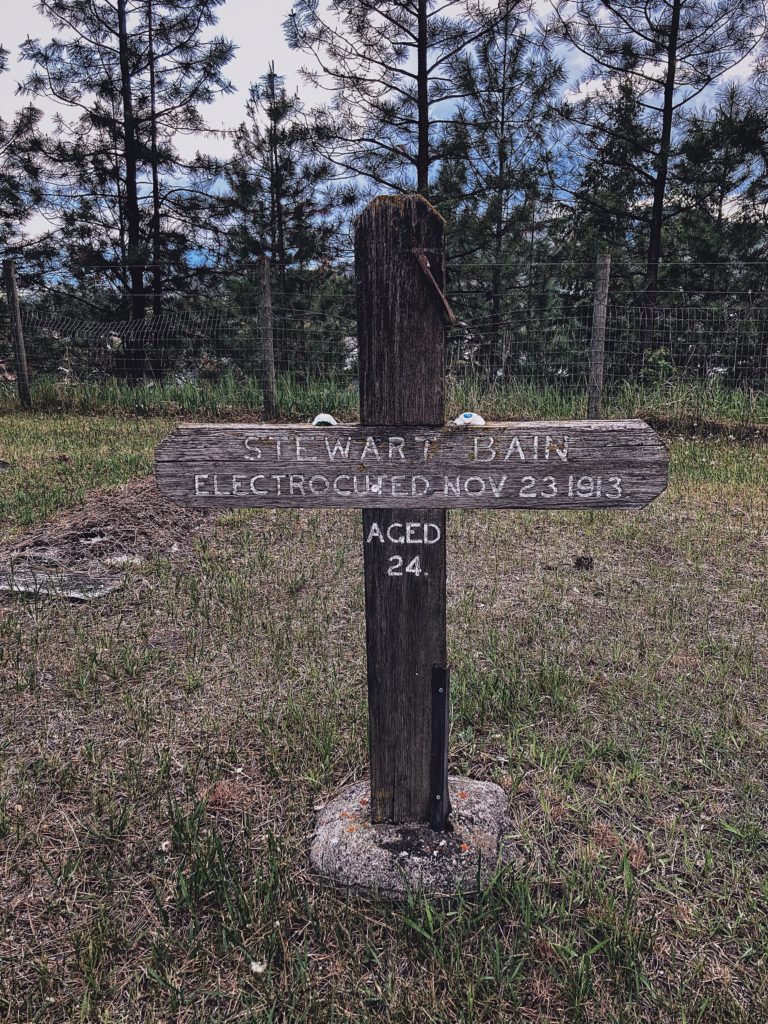
Save for those very rare cases where part of a body was laid to rest (or their ashes sprinkled or housed at) at one cemetery and another/the rest at a different one, it is very uncommon for one individual to reside at two different cemeteries.
Vernon is the oldest community in the Okanagan and while its present-day cemetery is not the region’s largest or most senior, having been established roughly 121 years ago and presently clocking in at about thirty acres, it is certainly amongst them.
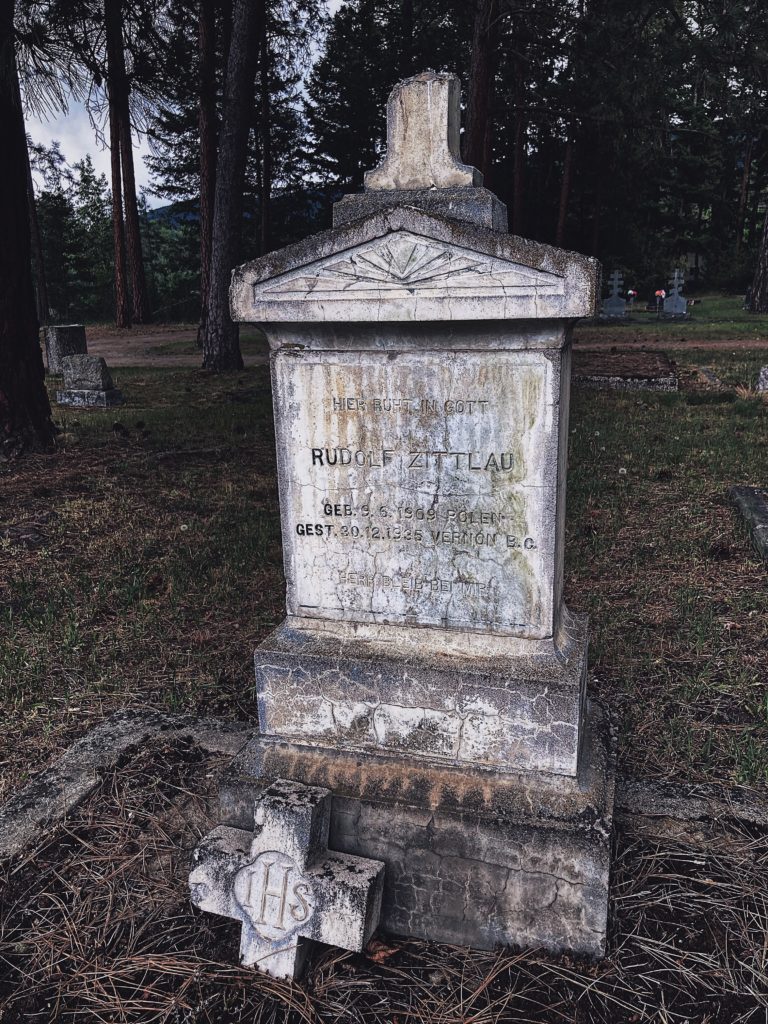
I feel very fortunate to live in a part of the country that is peppered with fascinating, beautiful, and diverse cemeteries up and down the region and to get the chance to visit some of them periodically.
For, after all, as I began this post by saying, the passing of time will eventually lead us all to our last breath. I have no idea if anyone will remember me after I am gone and my living relatives at the time have also crossed over.
Whether anyone will or not, while I am on this side of the soil, I make it my mission to remember and honour the lives, spirits, hopes, dreams, and accomplishments of all those who rest in eternal slumber at the cemeteries I am able to visit in person.
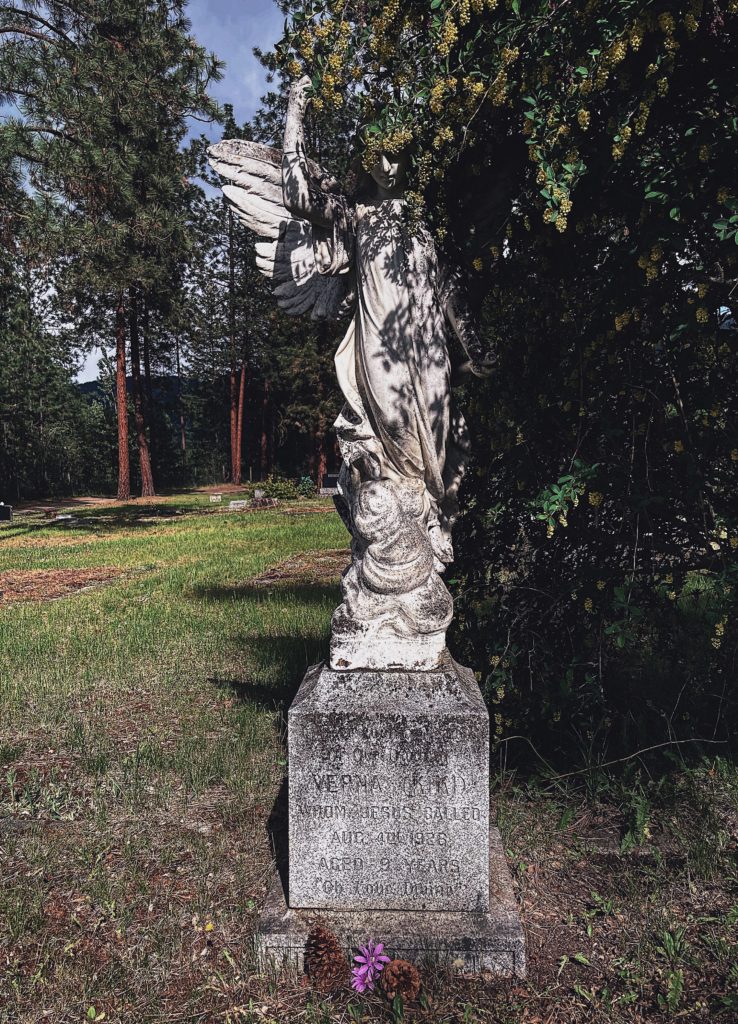
So long as my health permits, plans are in the works to spend time at some others around our region this year. It is a safe bet to say that future Cemetery Journey posts devoted to those equally poignant places will transpire here in due course as well. (I can hardly wait! 🥰)
What is your favourite season in which to spend time at cemeteries/graveyards? What was the last burial ground that you visited for non-funeral-related reasons? 🌼⚰️🖤

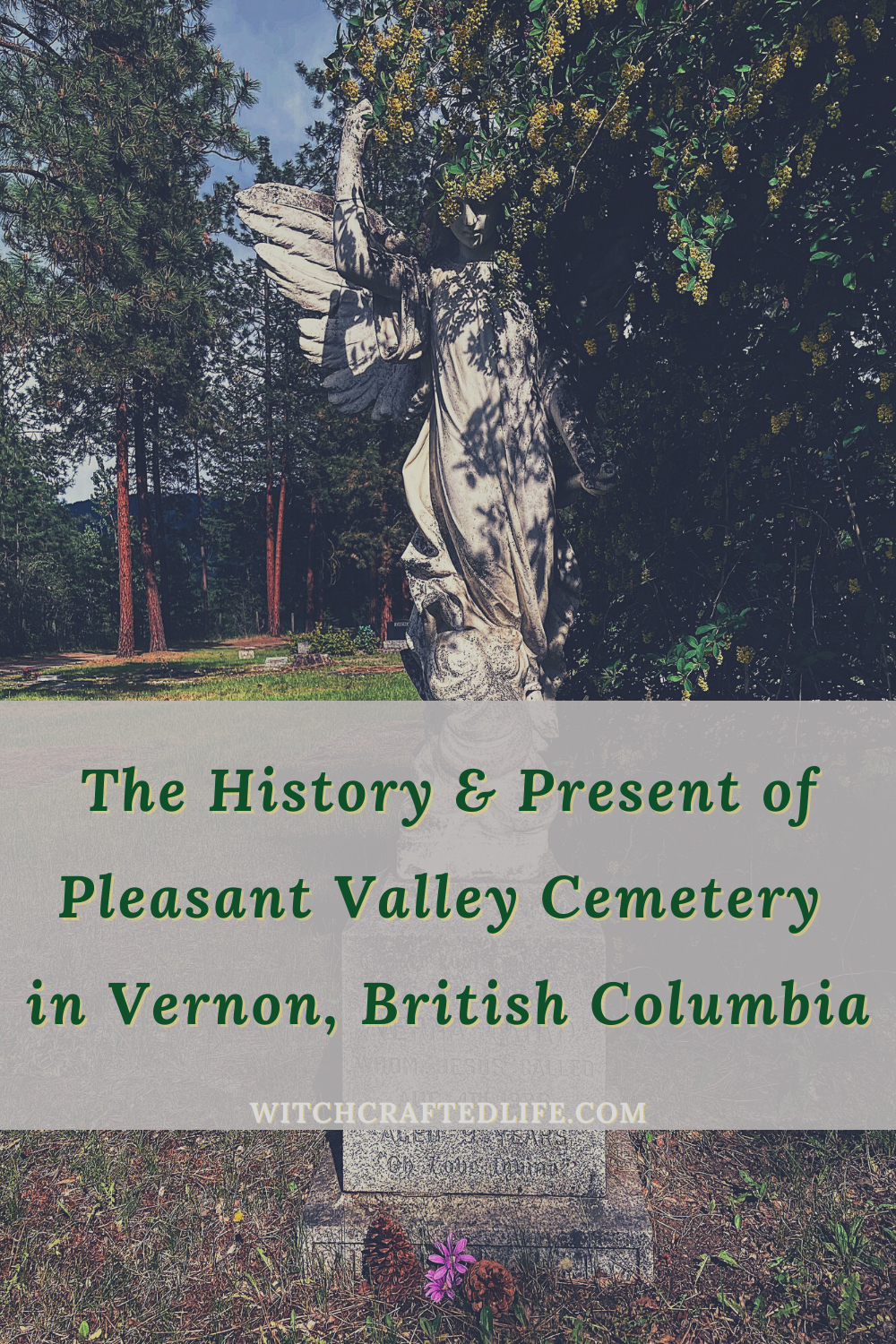

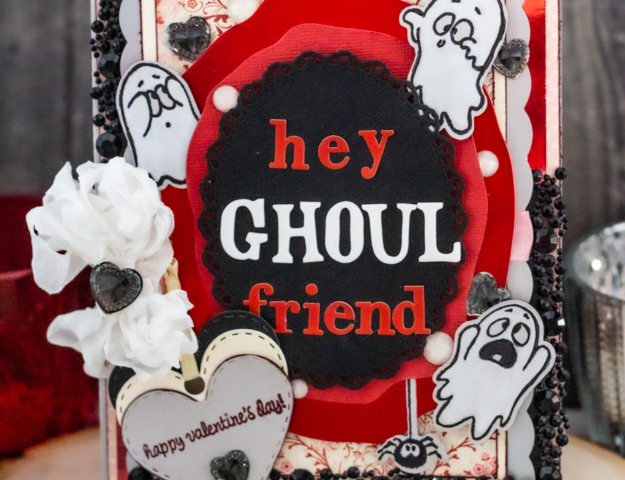
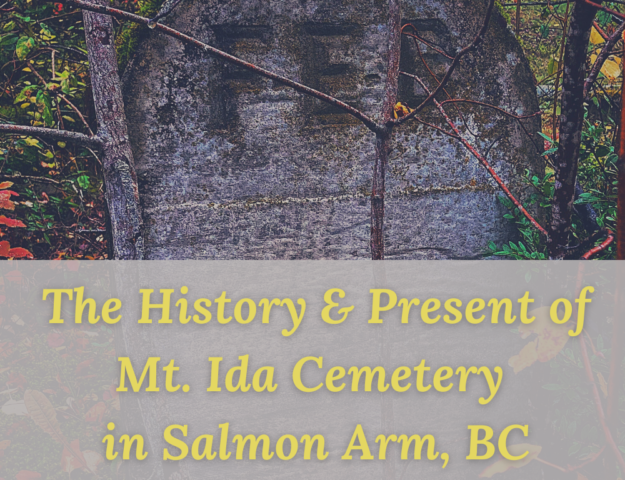
Such a rich history! I thoroughly enjoyed the photos of the headstones. We have a really old, historic cemetery here in my town. It’s been a long while since I’ve walked through it and this article makes me want to go check it out again. Glad to see things are finally blooming beautifully in your area Autumn!
Great article and fabulous photography! I like the heart, and bible headstones. The angel was gorgeous too!
What an interesting read, Autumn, and your photos of the cemetery and its time-worn headstones and monuments are stunning! xxx
Oh, that was lovely, Autumn, thank you! I really enjoyed reading about Vernon, and I realize – I have been there, as a child. My family spent a summer in the area around Kalamalka Lake – I even remember seeing a big paddlewheel-style boat, I think.
Wonderful article, full of your poetry.
This is so interesting and your pictures are fabulous, they provide a really good feel for the place and I do love that name. Who wouldn’t want to be buried in Pleasant Valley? These posts must take you such a long time to research and put together. Thank you for that, it is so nice to read about it all and learn about the area. You picked the perfect photo to start the post, the lilac is stunning and it frames the view perfectly. I have been enjoying all the lilac near me these last couple of weeks. Unfortunately it is now fading, which is alway sad. I have just recently purchased a lilac stamp too and have made a card using it. I hope it will get posted sooner or later. Thank you for educating me about the joys of cemeteries and the history of Vernon. I walk through my local cemetery because I love the trees. We have an old and a new cemetery. The old one is full of Yew trees and the new one is much more open but does have some stunning cherry trees, which get better as each year passes. xx
Lovely post and as always the reading was interesing. x
You always find such fascinating history and details! Really enjoyed the photographs and headstones! Thanks for sharing friend!
Wow, it was really interesting reading the history of the area and the graveyards! You must have put so much effort into this!
What an amazing journey you took through this cemetery, and the grave markers all amaze me! I wish I could still walk well and far enough to visit the cemetery of some of my ancestors but I will have to settle for photos such as these. Those lilacs are simply divine too! This was profoundly interesting and I enjoyed it,
What a wonderful post. I loved this deep dive into the history of the region and the range of headstones you shared!
xoxo
-Janey
What a lovely and quaint cemetery tour! I especially loved seeing the vibrant and beautiful lilacs and yellow blooms juxtaposed against the cemetery’s sense of death.
Such interesting tombstones too. What an interesting read, Autumn!
Debi